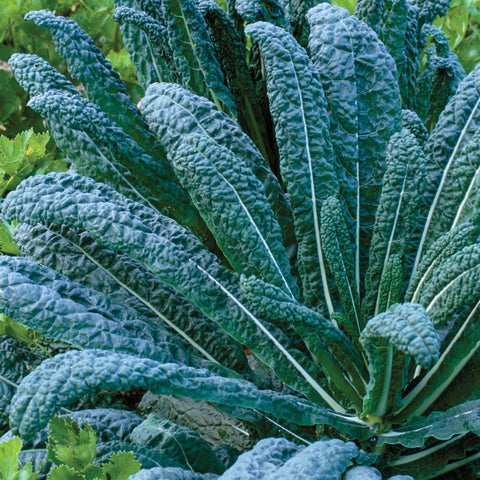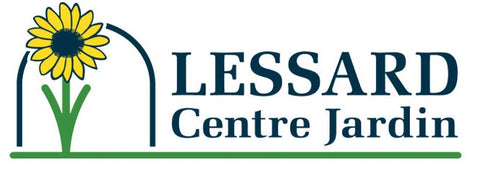
Hortinova
TOSCANA - Open Pollinated Kale Seeds
Brassica oleracea
- Italian heirloom variety, also known as Lacinato, Dinosaur, Strap, and Black Kale.
- Grows up to 3 feet tall with long, dark green, puckered leaves.
- Excellent flavor when young; stronger taste when mature, improving after frost.
- Popular for bunching, baby leaf market, and kale soups.
- Tolerant to hot and cold weather, suitable for various climates.
- Ornamental appearance with striking foliage.
- Open-pollinated seeds.
- Natural, Untreated, Non-GMO Seeds.
Kale plants are usually sown into a seedbed in open soil, or in cells or small pots to transplant to their final positions in summer. Five productive plants are often sufficient in a small garden. Early crops to harvest in summer can be sown directly into the soil or in large containers.
SOW IN THE SOIL: Raise young plants for transplanting in a short row 2-3 ft (60-90 cm) long. From mid-spring to early summer, make a drill ½ in (1 cm) deep with a cane or trowel and sow seeds thinly along it. Cover with soil, water, and label the row. Thin seedlings to 3 in (8 cm) when they are big enough to handle. You can sow early crops directly into their final positions from mid- to late spring, in rows 6 in (15 cm) apart.
SOW IN POTS: From mid-spring, fill small pots or cells with seed-starting mix. Sow one seed ½ in (1 cm) deep in the center of each. Cover, water, label, and place in a sheltered spot outdoors or on a bright windowsill.
TRANSPLANT: Plants originally sown in small pots or cells may need potting on into larger containers before they are ready to transplant into their final positions in early to midsummer. Plant out young kale into open soil when plants have five or six leaves. Plant them into well-drained, fertile, slightly alkaline soil. Space plants 18 in (45 cm) apart each way for main overwintering crops or 6 in (15 cm) apart each way for summer leaves. Dig a hole deeper than the root ball, position each plant with its lowest leaves just above the soil surface, and firm the soil around the roots. Thin direct-sown seedlings of early kale to 6 in (15 cm) apart.
WATER AND FEED: Water the seedlings thoroughly after transplanting and keep the soil consistently moist during summer. Weed around plants regularly. Mulch in fall to retain soil moisture and suppress weeds. Feed plants with a high-nitrogen fertilizer in early spring to boost growth.
PROTECT: Kale is fairly problem-free, but netting is a sensible precaution. Cover plants with fine netting or fleece to keep off egg-laying butterflies and pigeons.
Kale leaves are ready to harvest when they are about the width of an adult’s hand. Start harvesting early crops of summer kale three months after sowing, and main winter crops in late fall. Cut or snap the leaves from the base of the stem upward and pick evenly across all your plants. Kale will continue to grow slowly from the top of the leaf cluster during mild winter weather and some varieties put out tender side shoots in spring. Stop picking when flower stems appear, and the leaves toughen. Chop small leaves raw into summer salads; larger leaves are lovely steamed, stir-fried or added to soups and pasta dishes.
Let customers speak for us
from 19 reviewsBALCONY YELLOW F1 - Hybrid Cherry Tomato Seeds

Delivered very fast, packed very good, in professional condition and quality. Thanks

DUETT - Open Pollinated Radish Seeds

We will see what they are like this summer.

Type crimson de bonne grosseur avec une superbe uniformité et très hâtif. Un des premiers prêt en saison. Semences très petites et peu nombreuses. Goût très sucré et chaire croquante. Chair passant du rose au rouge en cours de saison. Les plants sont forts et très vigoureux avec des grosses feuilles.

Vigueur des plants impressionante avec des fruits résistants aux fissures et aux dommages. Très bonne conservartion et goût très sucré lorsque les nervures deviennent orange. Peu être récolté lorsque les nervures sont vertes également. Cavité des semences très compacte et petite laissant beaucoup de chair.

Melon qui fond en boûche avec un goût se rapprochant du melon miel et du cantaloup à la fois, très sucré. Faire attention aux irriguations lorsque le melon devient mature car il peut fendre au champs. Très odorant.

Avec son apparence côtellée, son très gros calibre et ça couleur rose, cette tomate se démarque des autres sur les tablettes. Variété plus résistante à la pourriture apicale que la plus part des autres tomates roses. Bon ensemble de résitance aux maladies également.

Tomate noire dont les faces qui ne sont pas exposé au soleil passent du vert au rouge lorsque mature donnant un aspect unique aux fruits. Charactéristiques similaires à la Barrio avec un goût superbe sans acide. Les clients l'on adoré.

Superbe adaptabilité et excellente résistance aux maladies. Fruits uniformes qui ne fendent pas, bonne conservation. Ajoutez à cela un goût unique avec une légère acidité et une pointe sucré.

Variété unique qui produit des melon eau jaune de gros calibre! Passe de jaune à orange plus il mûrrit sur le plant. Semences peu nombreuses et très petites. Couverture foliaire au champs excellente. Rendement excellent, donne 3 à 5 melons par plants.

Gros calibres avec une superbe uniformité dans les fruits. Goût et texture excellente pour un melon hâtif. Rendement exceptionnel avec une superbe couverture foliaire au champs.

Very good appearance and type.

TRISTAN F1 - Hybrid Summer Squash Seeds















